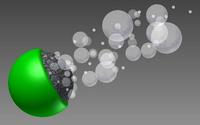-
Assad is still using chemical weapons. What will it take to stop him?
While the Syrian conflict has been perpetually overshadowed in the headlines by recent events such as the possibility of a Grexit and the Chinese stock market crash, two recent developments regarding Syria’s use of chemical weapons have nearly managed to refocus international attention on Syria. First, on June 17th the House Committee on Foreign Affairs convened a hearing on the Assad regime’s use of chlorine barrel bombs. Second, U.S. intelligence agencies publicly reported this week that they expect another attack by the regime using chemical weapons beyond chlorine bombs. In particular, the Syrian government is suspected of maintaining stocks of sarin and VX gas.
-
-
Better detection of diseases, fraudulent art, chemical weapons, and more
From airport security detecting explosives to art historians authenticating paintings, society’s thirst for powerful sensors is growing. Given that, few sensing techniques can match the buzz created by surface-enhanced Raman spectroscopy (SERS). Discovered in the 1970s, SERS is a sensing technique prized for its ability to identify chemical and biological molecules in a wide range of fields. It has been commercialized, but not widely, because the materials required to perform the sensing are consumed upon use, relatively expensive and complicated to fabricate. That may soon change.
-
-
Nano-coated mesh captures oil but lets water through
The unassuming piece of stainless steel mesh does not look like a very big deal, but it could make a big difference for future environmental cleanups. Water passes through the mesh but oil does not, thanks to a nearly invisible oil-repelling coating on its surface. In tests, researchers mixed water with oil and poured the mixture onto the mesh. The water filtered through the mesh to land in a beaker below. The oil collected on top of the mesh, and rolled off easily into a separate beaker when the mesh was tilted. The nano-coated mesh could clean oil spills for less than $1 per square foot.
-
-
Assad regime continues to employ chemical weapons
Syrian government troops had used chemical weapons against civilians and rebels on many occasions, culminating in an August 2013 deadly chemical attack against civilians in Ghouta, a Damascus suburb. That attack killed more than 1,200 people. Syria joined the OPCW in 2013 in the face of a threat of a U.S. military attack, admitting to owning about 1,300 tons of chemical weapons and ingredients for making toxic gas and nerve agents, and agreeing to give up this stockpile and destroy, under supervision, its chemical weapons production infrastructure. Western intelligence services have always suspected that Assad has not come clean, and that the regime still keeps secret chemical stockpiles. The continued use of chemical weapons in Syria means that the Assad regime agreed to refrain from developing new chemical weapons, but not from using existing inventory.
-
-
Strong evidence that Syrian government used chemicals in attacks on three cities
Evidence strongly suggests that Syrian government helicopters dropped barrel bombs filled with cylinders of chlorine gas on three towns in Northern Syria in mid-April 2014, Human Rights Watch said earlier this week. These attacks used an industrial chemical as a weapon, an act banned by the international treaty prohibiting chemical weapons that Syria joined in October 2013. The Syrian government is the only party to the conflict with helicopters and other aircraft.
-
-
Metal-organic framework quickly destroys toxic nerve agents
First used 100 years ago during the First World War, deadly chemical weapons continue to be a challenge to combat. Scientists have developed a robust new material, inspired by biological catalysts, which is extraordinarily effective at destroying toxic nerve agents that are a threat around the globe. The material, a zirconium-based metal-organic framework (MOF), degrades in minutes one of the most toxic chemical agents known to mankind: Soman (GD), a more toxic relative of sarin. Computer simulations show the MOF should be effective against other easy-to-make agents, such as VX.
-
-
Meals served to Turkey’s president Erdogan tested for poison
Turkish president Recep Tayyip Erdogan has implemented strict new measures to protect his personal security. One of these measures: Every meal he is served – both at home and abroad — is rigorously tested to make sure it does not contain any poisonous materials inserted by a would-be assassin. Dr. Cevdet Erdol, Erdogan’s personal physician, said that a special food analysis laboratory will be built at Erdogan’s lavish presidential palace to make sure all his food is safe to eat. “It’s usually not through bullets that prominent figures are being assassinated these days,” Erdol told the Hurriyet newspaper on Tuesday.
-
-
Color-changing film detects chemical weapons
In today’s world, in which the threat of terrorism looms, there is an urgent need for fast, reliable tools to detect the release of deadly chemical warfare agents (CWAs). Scientists are reporting progress toward thin-film materials that could rapidly change colors in the presence of CWAs — an advance that could help save lives and hold aggressors accountable.
-
-
Turning deadly chemical warfare agents into harmless soil
Destroying chemical warfare agents in bulk is a challenge for the military and international community. Current methods of eradication, such as incineration or hydrolysis, create toxic waste which requires further processing. The logistics required to transport large stockpiles from storage to a disposal site can be risky and expensive. DARPA is seeking portable system that turns stockpiles of chemical warfare agents into dirt or other safe organic compounds without generating hazardous waste.
-
-
New acoustic sensor for chemical, biological detection
Testing for ovarian cancer or the presence of a particular chemical could be almost as simple as distinguishing an F sharp from a B flat, thanks to a new microscopic acoustic device that has been dramatically improved by scientists at the Argonne National Laboratory. The device, known as a surface acoustic wave (SAW) sensor, detects frequency changes in waves that propagate through its crystalline structure. This makes it ideal for detecting the presence of chemicals or biomarkers present in a liquid or gas.
-
-
Microrockets fueled by water neutralize chemical and biological warfare agents

With fears growing over chemical and biological weapons falling into the wrong hands, scientists are developing microrockets to fight back against these dangerous agents. Scientists point out that titanium dioxide is one of the most promising materials available for degrading chemical and biological warfare agents. It does not require harsh chemicals or result in toxic by-products. There is no way, however, actively to mix titanium dioxide in waterways, so scientists have been working on ways to propel titanium dioxide around to accelerate the decontamination process without the need for active stirring.
-
-
Light frequencies help sniff out deadly materials from a distance

Spectroscopic chemical sensing, which measures the frequency of light absorbed or scattered from a substance to help determine its molecular identity, can be used to detect traces of biological and chemical agents and residue from explosive materials. New program aims to develop chip-sized, optical frequency combs which accurately identify even tiny traces of dangerous biological and chemical substances several football fields away.
-
-
Effective, inexpensive method to detect natural gas pipeline leaks
Major leaks from oil and gas pipelines have led to home evacuations, explosions, millions of dollars in lawsuit payouts, and valuable natural resources escaping into the air, ground and water. Scientists say they have developed a new software-based method that finds leaks even when they are small, which could help prevent serious incidents — and save money for customers and industry.
-
-
Assad retains secret caches of chemical weapons: Israeli intelligence
Despite committing to dismantle and give up its chemical weapons – Syria was in possession of the world’s largest chemical weapons stock — President Bashar al-Assad’s regime still maintains a “residual” chemical weapons capacity, consisting of a few tons of the proscribed materials. Israel’s intelligence community has concluded that the Assad regime has decided to keep this reduced, but still formidable, chemical weapons capability, and has successfully concealed it from the inspectors of the UN chemical weapons watchdog who, a few weeks ago, have declared the chemical disarmament of Syria to be officially complete. Israeli defense officials believe that these sarin gas weapons would likely be deployed if the Assad regime faced an imminent threat to its survival. The Syrian regime is continuing to use chemical weapons which were not covered by the U.S.-Russian chemical weapons disarmament agreement, especially chlorine gas.
-
-
Improved gas mask protects U.S. soldiers against lethal attacks
Choking. Watering eyes. Blistering skin. Convulsions. These are all symptoms of a chemical weapons attack that can lead to imminent death. The lethality of such attacks, most recently the one in Syria in August 2013, can send tremors across the globe. For U.S. Army soldiers, however, chemical weapons present a real danger on the battlefield, and one that requires the most advanced technology to keep them safe. Scientists and researchers at the U.S. Army Edgewood Chemical Biological Center (ECBC) have been working toward better protective equipment, including the iconic gas mask.
-
- All
- Regional
- Water
- Biometrics
- Borders/Immig
- Business
- Cybersecurity
- Detection
- Disasters
- Government
- Infrastructure
- International
- Public health
- Public Safety
- Communication interoperabillity
- Emergency services
- Emergency medical services
- Fire
- First response
- IEDs
- Law Enforcement
- Law Enforcement Technology
- Military technology
- Nonlethal weapons
- Nuclear weapons
- Personal protection equipment
- Police
- Notification /alert systems
- Situational awareness
- Weapons systems
- Sci-Tech
- Sector Reports
- Surveillance
- Transportation
Advertising & Marketing: advertise@newswirepubs.com
Editorial: editor@newswirepubs.com
General: info@newswirepubs.com
2010-2011 © News Wire Publications, LLC News Wire Publications, LLC
220 Old Country Road | Suite 200 | Mineola | New York | 11501
Permissions and Policies
Editorial: editor@newswirepubs.com
General: info@newswirepubs.com
2010-2011 © News Wire Publications, LLC News Wire Publications, LLC
220 Old Country Road | Suite 200 | Mineola | New York | 11501
Permissions and Policies
